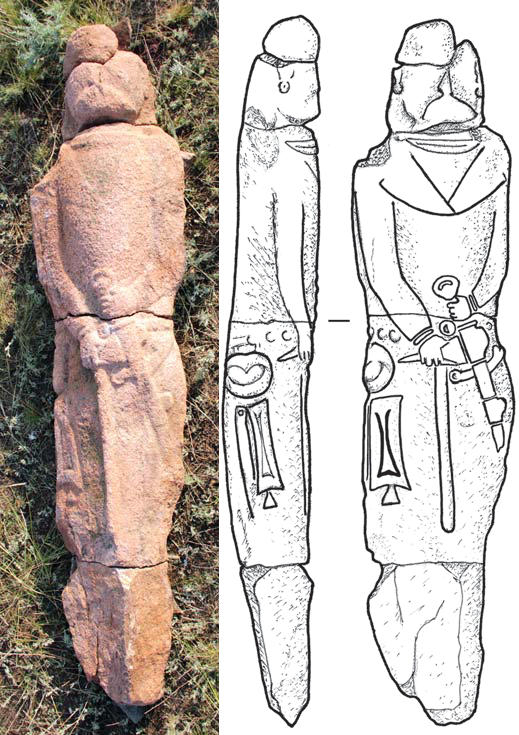
Amazon Audible Gift Memberships
An extract from:
An Old Turkic Statue at Borili, Ulytau Hills, Central Kazakhstan
by L.N. Ermolenko, A.I. Soloviev, and Z.K. Kurmankulov, 2016.

Fig. 1. Stone statue from Borili.


Description of the statue
The statue was discovered in the location of Borili1 at the confluence of the Tamdy and Terekty rivers (48º57' 155" N, 66º 59' 850" E, at an altitude of 483 m). The statue was probably located at the site of its original setting, at the eastern tail of an earthen mound 12 m in diameter and 0.4–0.5 m in height. Stones, including white quartz, were found on the surface of the mound. A presumably later stone pavement 6 m in diameter and 0.3 m in height, with missing stones in the middle, was located on the western side of the earthen structure. The sculpture is made out of a block of pink, coarse granite and represents a man holding weapons in each hand (Fig. 1). The size of the sculpture is 195 × 25–44 × 10–22 cm. The convex shape of the block and the proportions of the sculpture are close to those of a real-life figure, and give the impression of a three-dimensional sculpture. The reverse side of the sculpture is covered with coarse spalling, and bears no representations.
Although the sculpture had been toppled and broken some time in the past, it shows a satisfactory degree of preservation, with most damage on the head, which was split off. The representations of ears, with rounded pendant earrings, can be discerned on the sides of the head, and the outlines of the nose and (wide?) mustache are distinguishable on the face. The body of the sculpture was broken into three parts; the right shoulder was damaged by the spall. A narrow segment-like bas-relief, divided by a longitudinal line, a representation of a two-row neck adornment (a torque?), runs around the base of the neck. Narrow bracelets are shown on the wrists. The lapels of the coat are indicated on the chest of the figure. Although the line showing the edge of the coat is absent, the placement of the right lapel over the left suggests the left overlap of the clothing.
The belt is indicated by such details as a rounded buckle with a segment-like hole for the belt, six round onlay plates (three in a row on each side of the buckle), and a small fragment of the belt on the right side. According to the design of the buckle, the belt was fastened on the side opposite to the overlap of the clothing: that is, on the right. The hand of the half-bent left arm of the sculpture is above the belt, and is tightly holding the hilt of a long-bladed weapon (broadsword?) with an ovalring pommel and straight thin crossbar. A sheath with distinctive semicircular clips connecting the paired transverse braces is shown. The position of the sheath is almost vertical. A relief of a short-bladed weapon (knife or dagger) was carved below the upper clip and almost perpendicular to the broadsword. The blade of that weapon is enclosed in a sheath of asymmetrical triangular shape, with a similar device for fastening to the belt. The hilt of the weapon, located at an angle to the blade, is crowned with the ring pommel. The right hand of the sculpture is below the belt, over the middle part of a battle axe whose blade is facing left towards the bladed weapon. The axe has a trapezoidal blade, a wedge-shaped striker, and a long, straight handle reaching the border of the lower untreated part of stone, which was dug into the ground. We may assume that the figure that was carved of granite might have leaned on this weapon like on a staff. An oval hanging bag can be seen at the belt on the right side of the figure. The upper flap2 and a decorative edging, or the outline of a pocket-compartment sewn on the front side of the bag, are represented in relief. Two elongated objects “hanging” next to each other are carved under the bag. The front object (closest to the front plane) has the form of an elongated trapezoid with concave sides and a base, from which a triangle extends downwards possibly indicating a hanging truss. This object is probably also a small bag with a flap and a patch pocket. Its shape, locking system, and décor resemble a miniature quiver. We may assume that the bag was used for carrying elongated things (?). The rear object (closest to the back plane) apparently reproduces a whetstone with a hole for hanging.
1The location of the statue was reported by E. Omarov, the Junior Researcher of the Ulytau National Historical and Cultural Reserve and Museum, where the statue is presently being kept.
2The interpretation of this element as a flap was confirmed by Y.A. Sher (1966: Pl. II, 11; VII, 32; p. 78, 88).
...
On the basis of the artistic and material parallels, the statue dates to the 7th or early 8th centuries.
Source: Cultural Realia